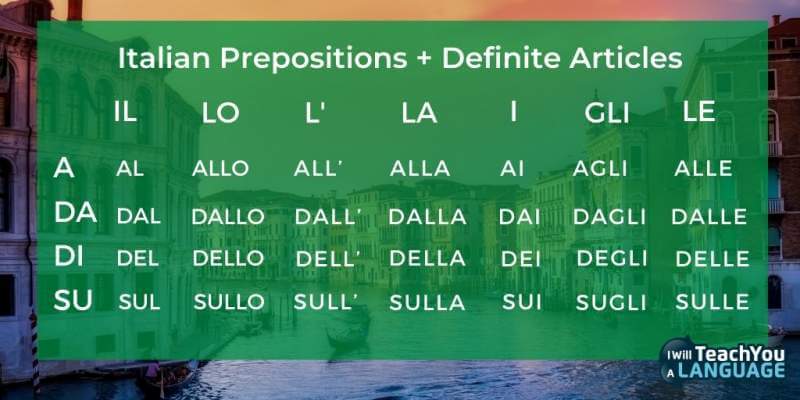
Learning Italian is fun, and it’s nice to be able to say that you speak it. But taking the first step towards actually learning how can be tough. Where should you start?
To help you get going, I’ve collected some very basic Italian grammar rules and tricks that anyone trying to start speaking Italian should know, so they can build a good base for the language to flower.
If you’ve ever listened to a Dean Martin song, you’ll be familiar with most beginner phrases in Italian that you should learn — Buona sera, bella, tarantella — so I'll skip those and go straight to some of the main rules.
By the way if you're learning Italian and you're intimidated by the grammar, then you're going to love Italian Uncovered. It's my course that will improve your Italian, no matter your level, with my unique StoryLearning® method. Click here to find out more and to try it out for free.
Table of Contents
#1 There Is No Such Thing As The Italian Language

At least not really. The language we call Italian today is actually a dialect of the Tuscan language spoken by people like Dante Alighieri, the famous Italian poet.
That’s like saying that since all the accents in the US are so different, they should all settle on one and speak the way Ernest Hemingway did, for example.
Either way, this still means that the local Italian dialects and languages have their very own set of rules and pronunciations. So that there’s really no end to things you can learn if you want to.
To make it easier if you want to learn standard Italian (in other words Tuscan), all of the rules below will be about that language, though some of these apply to all Italian languages, like the next rule.
#2 Things Have A Gender In Italian Grammar
Which they do in a lot of languages, though not English. In English, it’s the car, the train, and so on.
In Italy, you say:
- la macchina, because “the car” is female
- and il treno, because “the train” is male.
This is one of those things that there’s really no explanation for. And one that you won’t really be able to get around. But it’s definitely an area where mistakes are ok to make.
So don’t worry too much if to you, the gender of a wooden object is not immediately obvious.
That being said, there are a number of rules — and a whole bunch of exceptions — that help you determine which gender goes with which word.
For example, as you can see from the examples above, words that end in ‘a’ are generally female, while words that end in ‘o’ are mostly male. But neither is always true.
#3 Sometimes, How You Say It Is More Important

There are many languages that use accents, like Spanish, French, but also Hindi or German.
Some of these have a number of different kinds of accents, so compared to these, Italian is easy, since there really is only one, leaning into one of two directions. An Italian accent is either grave:` or acuto: ′
There are specific rules for using accents, like that the accent is always grave if the last letter of the accented word is one of the following: a, i, o, u, so that these become à, ì, ò, ù.
Check out the Italian accents post for more help with this.
#4 You, You And You
In English, you call someone “you” in the second person, no matter who they are. They could be your friend, teacher or a shopkeeper, the form doesn’t change.
In some languages, you can (and should) address someone in the second person in a more formal way, when needed. When, for example, you are speaking to someone who is older, or if it’s someone you don’t know.
In German, you’d use Sie, which is the same as “she” or “they,” but with a capital S, to make the difference clear when written. In Italian, tu becomes Lei, which also means “she” in Italian, though not “they,” and is also capitalized, unlike usted in Spanish or vous in French, which are lower case.
If you're speaking to a number of people formally, you're technically supposed to use Loro, though most people use Voi (more on that in the last point of this article).
In some places in Italy, people even use Voi in place of Lei, as was done in Italy a long time ago. People will understand if you do this, but it does sound a little weird to use Voi today.
It’s important to remember that lei doesn’t change with gender, but the adjectives do, so that you would tell a man formally La prego but Lei è simpatico.
For more on this, take a look at this post on Italian pronouns.
#5 There Are Cute Alterations In Italian

Alterations are a group of suffixes, or bits you add onto the end of a word that make no sense on their own but change the meaning of a word. Like this:
- Tavolo, table, becomes tavolino, little table,
- and cane, dog, becomes cagnolino, little dog.
In a lot of languages, most of these are diminutives, meaning that they make the original word either shorter or its meaning smaller or cuter. Like Bill is a diminutive of William, giocattolino is a diminutive of giocattolo, toy, which then means “little toy.”
But Italian is so rich in alterations that they have some that make things bigger, usually the suffix –one, as in gatto, cat, or gattone, large cat. (gattino is the small, gattuccio the cute cat)
Mamma becomes mammina, like mum becomes mommy, and asino becomes asinello or small, young donkey. Pretty easy! Bene, benissimo.
#6 Critical Clitics
Clitics are the thing that people trying to learn Italian struggle with the most. Clitics are a bit of a pain, it has to be said.
They are a group of pronouns that don’t work on their own and sometimes come before a verb, sometimes they come after, other times they are just tacked onto the end or even squeezed in the middle.
The thing to remember is that you use them when there is an indirect object. Like if someone says something about a cat, you don’t have to mention that the subject is the cat in every sentence.
You also have some freedom with how you use clitics, like this:
Lo devo fare (I must do [a specific thing already mentioned]), can become:
Devo farlo, and mean the exact same thing.
In the imperative form, they must in fact always be tacked to the end, as in:
- Allora, facciamolo! (So then, let us do it)
Here are some more examples of clitics:
- Non vedo Carla, ma ne vedo la macchina. (I can’t see Carla, but I can see her car. (“ne” in this case means “of her,” so that the sentence literally means “I can see the car of her”.))
- Non gli direi niente (I would not tell anything to him.)
- La vedo! (I can see her/it [feminine].)
- Mario me la lascia a casa. (Mario leaves it, the thing mentioned, at home for me.)
- Mario la lascia a me. (Mario leaves it to me.)
- Te ne lascia una. (lit. you, he leaves one of it.)
- Mario ne lascia una a te. (lit. Of it, Mario leaves one to you.)
- Mario dovrebbe lasciargliene una. (Mario should leave one to him/her/it/them.)
- Mario gliene dovrebbe lasciare una. (Mario should leave one to him/her/it/them.)
- Lasciamela! (Leave it to me/leave me it.)
…and so on, seemingly forever.
#7 Italian Adjectives To Adverbs
For something easier, an Italian adjective can be made into an adverb by adding –mente to the ending of the feminine singular form, like this:
- semplice (simple (feminine))
becomes
- semplicemente (simply)
Skip the e with adjectives ending in -re or -le before you add -mente:
- facile (easy)
becomes
- facilmente (easily)
You can also add emphasis, like this:
- lentamente (slowly)
becomes
- lentissimamente (very slowly)
#8 Italian Prepositions

In Italian, all basic Italian prepositions except for tra, fra, per and con have to have an article next to them.
So that:
- di (of, from)
can become del, dello, della, dell’, dei, degli, and delle
With the same going for:
da (from, by, since)
which can become dal, dallo, dalla, and so on.
- a (to, at)
can become al, allo, alla, all’, ai, agli or alle
- in (in, at, inside)
sometimes becomes: nel, nello, nella, nell’, nei, negli or nelle
- con (with)
can become con il or col, con lo, con la, con l’, con i or coi, con gli, con le
- su (on or about)
becomes sul, sullo, sulla, sull’ sui, sugli, sulle
Con and per have optional combining forms, instead:
- col, collo, colla, coll', coi, cogli, colle;
- pel, pello, pella, pell', pei, pegli, pelle;
The only two of the above you need to worry about are col and coi, because the others, like cogli or pelle, are hardly used in modern Italian.

#9 Easy Questions
Here is a wonderful and easy thing: in Italian, a lot (though not all) of the time, the question form of a sentence remains the same, so that it’s only the question mark or the tone that makes a question be a question.
- Francesca è a casa. (Francesca is at home.)
- Francesca è a casa? (Is Francesca at home?)
- Perchè sei l’ultimo a saperlo. (Because you are the last to know.)
- Perchè sei l’ultimo a saperlo? (Why are you the last to know?)
The key to getting this right is working on your Italian pronunciation so that people know from your tone that you're asking a question, not making a statement.
#10 Italian Grammar Rules That Italians Break

There are a great number of things Italians say that they, according to linguists, shouldn’t.
But what the linguists say bothers absolutely no one and so, even you can throw propriety to the wind and make use of some of this technically bad advice.
People often use the indicative form (the regular, not subjunctive form of the verb) where it’s not supposed to be used, for instance:
- Credo che Maria ieri fosse a casa (I believe that yesterday Maria was at home)
Normally, credo che should be followed by the Italian subjunctive.
…is correct, while
- credo che Giorgio ieri era a casa isn’t always, but that’s how most people say it.
Another example:
- Se Francesca fosse stata a casa, le avrei telefonato (if Francesca had been at home, I would have telephoned her)
…is correct but considered too formal by most, so they just say:
- se Maria era a casa le telefonavo, which is technically incorrect but used all the time.
Ma però is frequently used in spoken language, which is incorrect because ma and però both mean the same thing. So it’s like saying “but but”, which in English would sound odd!
If you remember we discussed the word group with the funny name, clitics, like mi, ti, gli, le, si, ci, vi. These are often doubled in a way that isn’t correct, but is so frequent that nobody minds:
- a me mi hanno dato una borsa (to me they gave (me) a purse)
and
- a loro gli hanno dato una macchina (to them they gave (them) a car)
So you can see, rules really are made to be broken, at least in the Italian language.
#11 A Or Ad And E Or Ed
Euphony is a word of Greek origin that translates to something like “pleasant sound.” In the context of language, it’s used as a way to guess how to say something correctly by feeling, or by how good it sounds.
This is useful in a whole bunch of situations (like German natives would tell you, for deciding if something is der, die or das), but often misused in the Italian language for something that is actually quite simple.
Learn this and watch as Italians look at you with wonder. In reasonably formal Italian, when a (to) or e (and) come before a word that starts with the same letter, you tack a d at the end of the article.
So easy, yet so often done wrong, because many Italians do this with all vowels, instead of just the same one.
- Andrea ed Elisa sono arrivati (Andrea and Elisa have arrived)
is correct, while
- Elisa ed Andrea sono arrivati is not, because Andrea doesn’t start with an e.
- Vado ad Ancona (I am going to Ancona)
is correct, while
- Vado ad Empoli is not, and that’s literally all there is to it.
Italian Grammar FAQ
What are Italian grammar rules?
Italian grammar follows consistent rules with some exceptions. It uses gendered nouns (masculine and feminine) and articles that must agree in gender and number.
Verbs are conjugated based on tense, subject, and mood. Word order is typically subject-verb-object, though it can vary for emphasis.
Is Italian grammar difficult?
Italian grammar can be challenging for beginners, especially due to verb conjugations and agreement rules. However, its patterns are regular, making it easier to learn over time. With practice and immersion, learners often find Italian grammar manageable.
What is Italian grammar like?
Italian grammar is highly structured, with clear rules for noun-adjective agreement, verb conjugations, and sentence formation.
It places emphasis on gender and number agreement and uses a variety of tenses and moods for verbs. The language also relies on prepositions to express relationships and nuances.
What is the Italian grammar pattern?
The basic pattern in Italian sentences is Subject + Verb + Object (e.g., Io mangio la pizza – I eat the pizza). Adjectives usually follow nouns (una casa bella – a beautiful house).
Verb conjugation patterns are central to the grammar, changing based on the subject, tense, and mood.
Italian Grammar Basics

So there you have it – 11 Italian grammar rules to get you started on your journey to Italian fluency.
You don't need to know all the ins and outs of Italian grammar to start speaking the language, despite what the grammar villain might say.
In fact, concentrating on just a few points makes more sense as you're able to spend less time with your nose in a grammar book and more time actually using the language.
In fact, that's exactly what I did when I learned Italian from home in 3 months. Instead of starting with textbooks and grammar books, I focused on immersing myself in the language through Italian podcasts and Italian books.
The more I saw the key grammar in context, the less I needed to “study” it. And in fact, learning Italian that way actually made it easier to start using the language in conversation.
So, look out for these Italian grammar points as you make contact with the language. The more you do, the more naturally and effortlessly you'll be able to speak Italian.

Olly Richards
Creator of the StoryLearning® Method
Olly Richards is a renowned polyglot and language learning expert with over 15 years of experience teaching millions through his innovative StoryLearning® method. He is the creator of StoryLearning, one of the world's largest language learning blogs with 500,000+ monthly readers.
Olly has authored 30+ language learning books and courses, including the bestselling "Short Stories" series published by Teach Yourself.
When not developing new teaching methods, Richards practices what he preaches—he speaks 8 languages fluently and continues learning new ones through his own methodology.









































